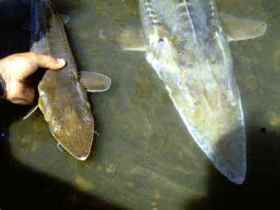Turning soybeans into caviar

In an ongoing effort to find new uses for soy-based products, a new study has kicked off at Southern Illinois University in Carbondale (USA) for shovelnose sturgeon caviar production.
“We’re initially going to be determining the nutritional and environmental requirements for the shovelnose sturgeon and ultimately developing a soy-based diet for high value caviar production,” said Brian Small, SIUC professor of aquaculture.
The Illinois Soybean Association provided start-up funding for three-year sturgeon caviar research project at SIU. “Research such as this helps create new uses for soy products,” Small said at the recent ISA research forum.
The shovelnose sturgeon is an important commercial fish in Illinois and the Midwest and also produces a very high-value product, marketed as “hackleback” caviar.
The shovelnose sturgeon commonly is found in the Mississippi and Missouri river systems. One ounce of caviar from shovelnose sturgeon is sold for between $30 and $50.
“With the rather recent shutdown of the caviar industry in Siberia and Russia, as well as putting species in the U.S. such as the pallid sturgeon on the endangered species list, a lot of focus has been on the shovelnose sturgeon fishery,” Small noted.
“However, because the pallid now are an endangered species, they’re actually cutting back on the areas we can fish shovelnose sturgeon. So this is only going to increase the demand for this caviar even further.”
Early maturing
The shovelnose sturgeons also are used for caviar production because they mature early. These fish mature between five to eight years old and begin egg production, while some other fish in the sturgeon family mature between 15 to 25 years old before they can produce caviar.
“Based on the work I’ve done with channel catfish, I think we can get this down to two to three years and be able to produce caviar in a much shorter time,” Small said.
The shovelnose sturgeon also is attractive for the soybean research because they are good candidate for efficient utilization of a soy-based diet, according to two recent studies.
Growth and roe development
The primary objectives for this research are to determine the protein and energy requirements for growth and roe (ovary) development and formulate and evaluate soy-based diets to meet requirements for growth.
The research also will look at developing feeding practices and production methods to maximize soy utilization for efficient growth and roe production.
The goal of this research is to develop soy-based feeds for growth and caviar production, establish a cultured caviar industry in Illinois and develop a high-value ometa-3 enriched caviar targeted to Asian markets.
In Japan there is a high demand for not only caviar, but also for products high in omega-3. “If we can make a caviar that’s high in omega-3, we can take that price of $30 to $50 for one ounce of caviar and maybe even double that,” Small said.











